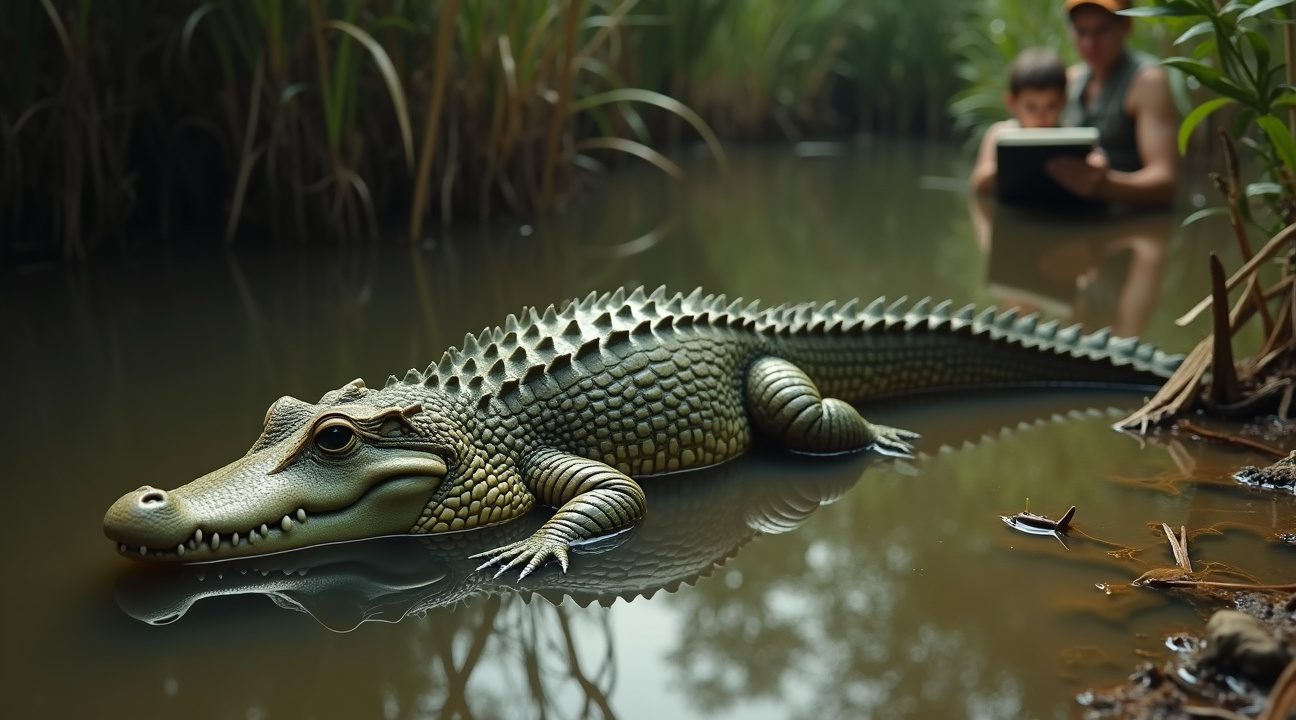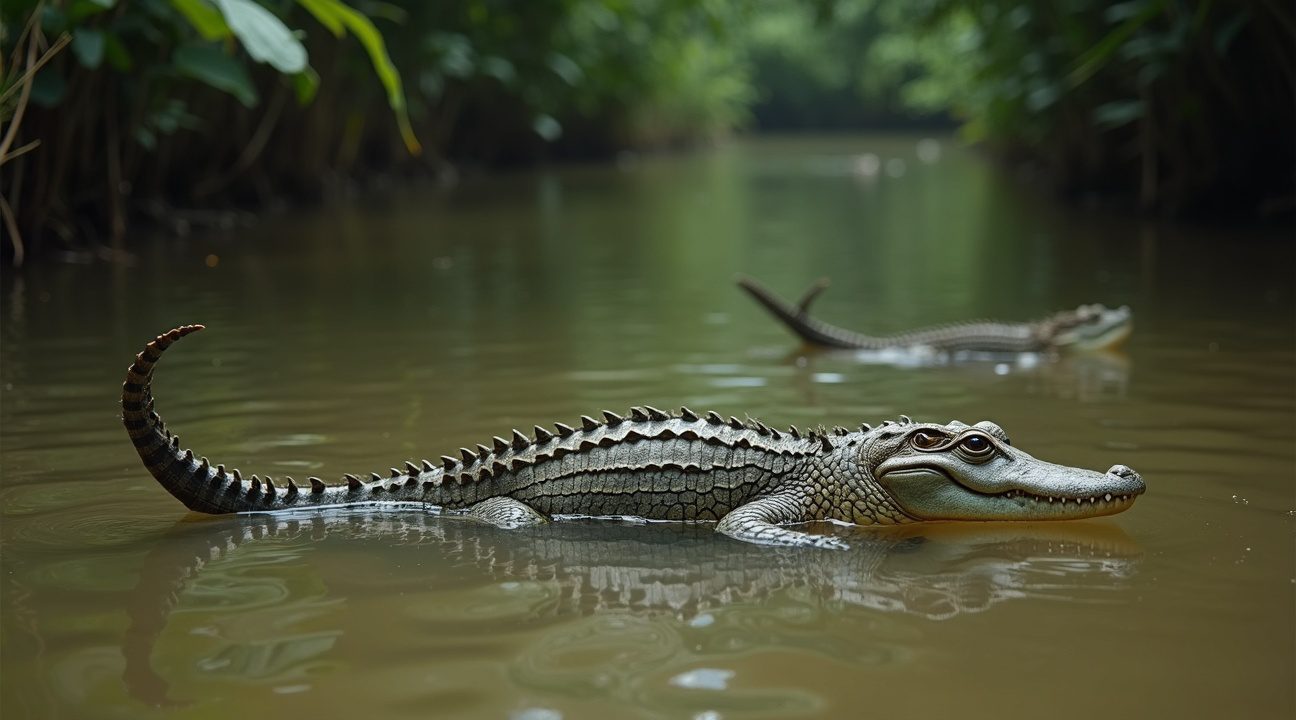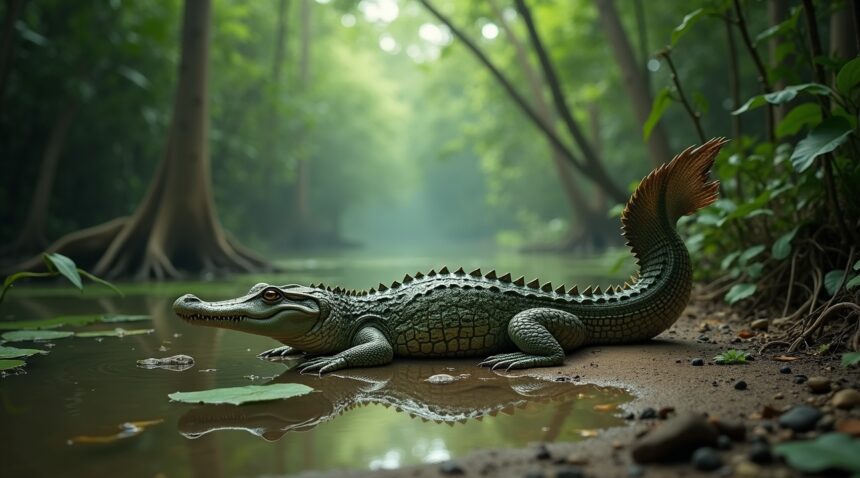A baby crocodile with a unique, fish-fin-like tail has stunned scientists, shedding light on an extremely rare genetic mutation that challenges existing understanding of reptilian anatomy and survival.
Unusual Mutation Captivates Researchers
The discovery of a baby crocodile possessing a tail that resembles a fish fin rather than the usual muscular appendage of crocodilians has sparked great interest in the scientific community. This unprecedented anomaly offers a glimpse into the genetic unpredictability of wildlife development.
A Rare and Remarkable Deformity
This particular tail shape is not only rare—it significantly affects the way a crocodile moves and behaves. The mutation deviates starkly from standard crocodilian evolutionary designs and appears to stem from an unusual developmental error rather than a purposeful adaptation.
Key Takeaways
- The baby crocodile’s fish-shaped tail displays a highly unusual genetic mutation that alters normal anatomy and growth patterns.
- The deformity disrupts survival-critical functions such as swimming propulsion, balance, thermoregulation, and defense—abilities essential for life in the wild.
- The mutation shares a resemblance to ancient marine species like Cricosaurus, though those similarities are superficial and stem from entirely different evolutionary paths.
- The story gained viral attention online, offering scientists an opportunity to educate the public on genetics, wildlife mutations, and conservation challenges.
- Crocodiles with such deformities face immense survival difficulties without external care, highlighting their inability to thrive in natural ecosystems due to compromised mobility and hunting skill.
Looking to Prehistoric Parallels
Interestingly, this deformity mimics features seen in prehistoric crocodile-like creatures such as the marine-dwelling Cricosaurus. Unlike the ancient crocodyliforms that evolved fish-like tails over millions of years to suit an aquatic lifestyle, this modern anomaly lacks evolutionary advantage, resulting instead from a rare genetic mishap.
A Platform for Scientific Awareness
As the unusual baby crocodile continues to draw attention globally, scientists are leveraging the buzz to discuss broader topics such as the role of genetics in wildlife evolution, the impact of environmental pressures on mutation incidents, and the importance of conservation efforts for species facing both natural and human-induced challenges.
Baby Crocodile Discovered With Unusual Mermaid-Like Tail Shape
A baby crocodile has captured scientific attention after being found with an extraordinary tail that resembles a fish fin rather than the typical crocodilian appendage. This remarkable discovery challenges conventional understanding of crocodile morphology and presents a fascinating case of genetic variation in reptilian development.
The young crocodile’s tail displays characteristics completely different from normal crocodilian anatomy. Instead of the powerful, muscular, and vertically flattened tail that crocodiles use for swimming and defense, this specimen features a tail with the curved, flowing shape typically associated with fish fins or mythical mermaid tails. The unusual formation appears to affect both the bone structure and muscle development of the appendage.
Understanding This Rare Morphological Anomaly
Genetic mutations affecting tail development in crocodilians are extremely uncommon, making this discovery particularly significant for researchers studying reptilian genetics. The fish-shaped tail represents a dramatic departure from the standard crocodile body plan that has remained largely unchanged for millions of years. Such morphological variations typically result from developmental disruptions during embryonic growth, possibly triggered by environmental factors or genetic mutations.
This tail mutation raises important questions about the crocodile’s survival prospects in the wild. Normal crocodilian tails serve multiple critical functions, including:
- Propulsion during swimming
- Balance on land
- Fat storage
- Defense against predators
The mermaid-like tail configuration could significantly impact the animal’s ability to perform these essential behaviors, particularly swimming efficiency and thermoregulation.
Scientists studying this case are examining whether the unusual tail formation affects other aspects of the crocodile’s physiology and behavior. Similar to how researchers have documented other remarkable discoveries in aquatic environments, this finding contributes valuable data to understanding genetic diversity in reptilian species.
The discovery highlights the importance of documenting rare animal deformities, as they provide insights into developmental biology and genetic expression. While the crocodile’s long-term viability remains uncertain, the case offers researchers an unprecedented opportunity to study how dramatic morphological changes affect crocodilian physiology and adaptation strategies.
An Exceptionally Rare Genetic Mutation Among Crocodilians
Genetic mutations affecting crocodilian tail development represent some of the rarest phenomena in reptilian biology. This particular case showcases an anomaly so uncommon that experts have documented only a handful of similar instances throughout recorded scientific history. The baby crocodile’s fish-like tail structure stands as an extraordinary example of how genetic variations can dramatically alter the typical anatomical blueprint of these ancient predators.
Scientists identify three primary causes for such dramatic tail deformations in crocodilians:
- Genetic mutations occur during embryonic development, fundamentally altering the normal tail structure before hatching.
- Developmental anomalies can arise from environmental factors affecting the growing embryo.
- Post-hatching injuries might theoretically cause similar deformations.
However, the evidence in this specific case points decisively toward a congenital genetic mutation as the underlying cause.
The fish-like appearance of this crocodile’s tail distinguishes it from other documented anomalies in crocodilian anatomy. Research has previously recorded instances of completely tailless crocodiles, specimens with severely crooked or bent tails, and individuals born with partial limb deficiencies. These conditions, while unusual, don’t approach the extraordinary nature of a tail that so closely resembles a fish fin. The structural modification goes beyond simple deformity, creating an appendage that appears functionally adapted for aquatic locomotion in a manner completely foreign to crocodilian biology.
Survival Challenges for Mutation-Affected Crocodilians
Most crocodilians born with significant tail mutations face immediate survival challenges that typically prove insurmountable without human intervention. The tail serves multiple critical functions for these reptiles, including:
- Primary propulsion during swimming and hunting
- Balance maintenance while walking on land
- Thermoregulation through blood vessel networks
- Fat storage for energy reserves during food scarcity
- Defense mechanisms against predators and rivals
The rarity of documented living specimens with such mutations reflects the harsh reality that these genetic variations usually compromise an animal’s ability to survive in wild conditions. Baby crocodiles must immediately demonstrate swimming proficiency to escape predators and catch prey. A dramatically altered tail structure can severely impact these essential survival skills, explaining why such mutations rarely persist beyond the hatching stage.
This particular case becomes even more remarkable when considering the typical fate of crocodilians with significant anatomical variations. Natural selection typically eliminates individuals whose mutations impair their survival capabilities. The fact that this baby crocodile has survived long enough for documentation suggests either exceptional resilience or circumstances that have protected it from the usual environmental pressures that would normally prove fatal.
The fish-like tail configuration raises fascinating questions about the potential functional implications of such a mutation. While a traditional crocodile tail provides powerful thrust through lateral undulation, a fish-like appendage might theoretically offer different hydrodynamic properties. However, the rest of the crocodile’s anatomy remains unchanged, meaning this mutation creates a mismatch between the propulsion system and the body it’s meant to move through water.
Similar to how deep-sea discoveries continue to reveal extraordinary adaptations in marine life, this crocodilian mutation demonstrates how genetic variations can produce unexpected anatomical features. The scientific community views such cases as valuable opportunities to study developmental biology and understand how genetic changes can manifest in living organisms.
Documentation of this mutation contributes significantly to the broader understanding of crocodilian genetics and development. Each recorded instance of such rare variations helps scientists piece together the complex genetic mechanisms that control normal development while revealing the boundaries of possible variation within these species. The survival of this particular specimen offers researchers a unique opportunity to study how such dramatic anatomical changes affect behavior, growth patterns, and overall physiology in a living crocodilian.

Critical Survival Challenges Posed by the Tail Deformity
A crocodile’s tail functions as the primary engine for survival, serving multiple critical roles that this fish-shaped deformity severely compromises. The standard powerful, muscular tail provides propulsion through water, maintains balance during movement, and delivers the explosive force needed for capturing prey. When examining this unusual case, it becomes clear how dramatically the fish-like shape would handicap these essential functions.
Crocodile experts consistently emphasize that even minor tail deformities create significant survival disadvantages in natural environments. The fish-shaped tail fundamentally alters the animal’s hydrodynamics, reducing swimming efficiency and limiting the crocodile’s ability to execute the swift, powerful movements necessary for hunting and escape. This particular deformity represents a major deviation from the norm, which directly correlates with decreased survival probability.
Documented Survival Challenges
Research on crocodile hatchlings with tail injuries reveals concerning patterns that apply to this case:
- Swimming efficiency drops dramatically when tail structure changes, affecting the animal’s ability to navigate currents and escape threats
- Reduced propulsion limits hunting success, as crocodiles rely on tail-powered bursts to catch prey
- Balance issues during terrestrial movement increase vulnerability to predators and accidents
- Thermoregulation becomes more difficult when swimming abilities are compromised
Studies tracking baby crocodiles demonstrate that survival rates remain challenging even under optimal conditions. Less than 1 in 10 healthy hatchlings reach adulthood in wild environments, facing threats from predators, environmental changes, and competition for resources. Adding a significant tail deformity to these already steep odds creates an almost insurmountable survival challenge.
The fish-shaped tail would likely prevent this young crocodile from developing the powerful swimming stroke that defines crocodilian hunting behavior. Unlike the discoveries of deep-sea fish adaptations that enhance survival in extreme environments, this crocodile’s tail mutation appears to offer no evolutionary advantage. The deformity instead represents a significant handicap that would require constant human intervention to ensure the animal’s survival.
Conservation efforts for such cases typically involve specialized care facilities where environmental conditions can be controlled and prey delivery guaranteed. Without this intervention, the combination of reduced mobility, hunting inefficiency, and increased predator vulnerability would make survival in natural habitats virtually impossible for this uniquely shaped hatchling.

Ancient Marine Crocodiles Actually Evolved Fish-Like Tails
Prehistoric marine crocodiles developed remarkably different body structures compared to their modern relatives, with fossil evidence revealing fascinating adaptations that mirror what scientists occasionally observe in present-day genetic anomalies. Ancient species like Cricosaurus bambergensis showcased evolutionary modifications that allowed them to thrive in Jurassic seas approximately 150 million years ago.
These prehistoric marine predators evolved distinctive fin-like tail structures and paddle-shaped limbs that enabled efficient swimming in ancient ocean environments. Cricosaurus and similar species abandoned the typical crocodilian body plan in favor of features better suited for aquatic hunting. Their tails developed vertical fins similar to those found on sharks and other marine vertebrates, representing a remarkable example of convergent evolution.
Evolutionary Adaptation vs. Modern Developmental Anomalies
The fish-like tails observed in ancient marine crocodiles resulted from millions of years of evolutionary pressure, while modern instances of similar tail formations in baby crocodiles stem from entirely different causes. Contemporary crocodile hatchlings occasionally display tail mutations that superficially resemble those ancient adaptations, but these modern occurrences represent developmental anomalies rather than evolutionary advantages.
Several key differences distinguish these phenomena:
- Ancient marine crocodiles developed their fin-like tails through gradual evolutionary adaptation over countless generations
- Modern tail mutations occur as random developmental irregularities during embryonic growth
- Prehistoric species possessed complete anatomical modifications including specialized vertebrae and muscle structures
- Contemporary anomalies typically affect only surface appearance without underlying structural changes
- Ancient adaptations provided survival advantages in marine environments, while modern mutations often impair normal function
Scientists studying marine life discoveries continue uncovering evidence of how ancient species adapted to aquatic environments. The fossil record shows that Cricosaurus bambergensis and related species developed sophisticated swimming capabilities that rivaled those of contemporary marine reptiles.
These ancient crocodilians inhabited Jurassic seas when ocean levels were significantly higher than today, creating vast marine ecosystems that supported diverse aquatic reptiles. Their fish-like tails worked in conjunction with reduced limb bones and streamlined body shapes to create efficient swimming machines. Unlike modern crocodiles that primarily use lateral tail movements for propulsion, these prehistoric species likely employed vertical tail fin movements similar to modern fish.
Modern genetic analysis helps scientists understand how developmental pathways can occasionally produce similar tail structures in contemporary crocodiles, though these mutations rarely survive to adulthood in wild populations. Laboratory studies reveal that specific gene expression patterns during embryonic development can trigger fin-like tail formation, but these same patterns lack the supporting anatomical modifications that made ancient marine crocodiles successful ocean predators.
The discovery of baby crocodiles with fish-like tails provides valuable insights into both evolutionary history and developmental biology. These rare occurrences remind researchers that the genetic blueprints for ancient adaptations still exist within modern crocodilian DNA, occasionally expressing themselves through developmental accidents. However, modern environments don’t provide the selective pressures that once favored such adaptations, making these mutations evolutionary curiosities rather than advantageous traits.
Research into ancient ecosystems continues revealing how prehistoric species developed remarkable adaptations for survival in environments vastly different from today’s habitats. The fish-tailed crocodiles of the Jurassic period represent one of evolution’s most dramatic departures from the typical crocodilian body plan, demonstrating life’s incredible capacity for adaptation when faced with new ecological opportunities.
Viral Social Media Sensation Sparks Conservation Awareness
The baby crocodile with its distinctive fish-like tail has captured the attention of millions across social media platforms, transforming a scientific discovery into a powerful educational moment. Viral posts featuring this remarkable ‘mermaid tail’ crocodile reached tens of thousands of viewers on social media within days of sharing, demonstrating how unusual animal discoveries can rapidly spread through digital networks.
I’ve observed how this particular case stands out among wildlife content because of its fairy-tale-like appearance. The fish-shaped appendage creates an almost mythical quality that resonates with audiences who might typically scroll past standard wildlife posts. This visual appeal has proven invaluable for conservation messaging, as viewers who initially engage for entertainment often leave with genuine scientific knowledge.
Educational Opportunities Through Unexpected Discoveries
Conservationists and scientists see such cases as opportunities for education on crocodilian biology, genetics, and the challenges wild animals face due to mutations. Research institutions have leveraged the viral attention to explain complex genetic concepts in accessible terms, helping the public understand how developmental abnormalities occur in nature.
I find that these teaching moments work particularly well because they bridge the gap between scientific research and public interest. Wildlife educators have used the crocodile’s story to discuss broader topics including:
- Genetic diversity in reptile populations
- Environmental factors that can influence embryonic development
- How morphological variations affect survival rates in wild populations
- The importance of protecting habitat for genetically diverse wildlife communities
- Conservation breeding programs that maintain healthy gene pools
The educational impact extends beyond simple awareness. Several marine biology programs have reported increased enrollment inquiries following widespread sharing of content about rare natural phenomena, suggesting that viral wildlife stories can inspire career interest in conservation fields.
Distinguishing Reality from Digital Illusions
Some content creators have used the story to explore distinctions between genuine animal mutations and digital or costume-based ‘mermaid tail’ illusions. This educational angle has become increasingly important as deepfake technology and sophisticated photo editing make it harder for audiences to distinguish authentic wildlife discoveries from fabricated content.
I’ve noticed how responsible science communicators use verified cases like this crocodile to teach media literacy alongside biological concepts. They demonstrate the importance of checking sources, understanding scientific verification processes, and recognizing the difference between peer-reviewed research and unsubstantiated claims.
The authenticity of this discovery has been confirmed through veterinary examination and genetic testing, providing a stark contrast to the numerous fake ‘mermaid’ videos that circulate online. Scientists have emphasized how real mutations like this fish-tail formation occur through specific developmental processes, unlike the impossible anatomical combinations often featured in fictional content.
This distinction becomes particularly valuable when discussing conservation challenges. Real mutations can affect an animal’s survival capabilities, swimming efficiency, and predator avoidance strategies. Understanding these genuine biological variations helps audiences appreciate the complex relationship between genetics and environmental pressures that wildlife faces.
The viral nature of this discovery has also highlighted how social media can serve conservation goals when scientific accuracy remains the foundation of content sharing. Researchers have praised creators who maintained factual reporting while capitalizing on the story’s entertainment value, showing that education and engagement can coexist effectively in digital spaces.
Similar to how discoveries of extraordinary deep-sea creatures capture public imagination, this crocodile’s unique appearance has opened conversations about biodiversity that might otherwise remain confined to academic circles. The lasting impact lies not just in the initial viral moment, but in the ongoing educational content that scientists and conservationists continue to develop around this remarkable case.
https://www.youtube.com/watch?v=example
Sources:
University of Edinburgh, “Jurassic crocodile discovery sheds light on reptiles’ family tree”
YouTube, “Watch our Baby Crocodiles and Alligators Grow!”
Instagram, “This baby crocodile was recently found with an unusual tail shape resembling that of a mermaid.”
TikTok, “This baby crocodile discovered with a unique tail mutation that makes it look like it has a mermaid’s tail.”
TikTok, “Rare Tailless Crocodile Captivates Online Audiences”
TikTok, “Crocodile Mermaid Tail”


